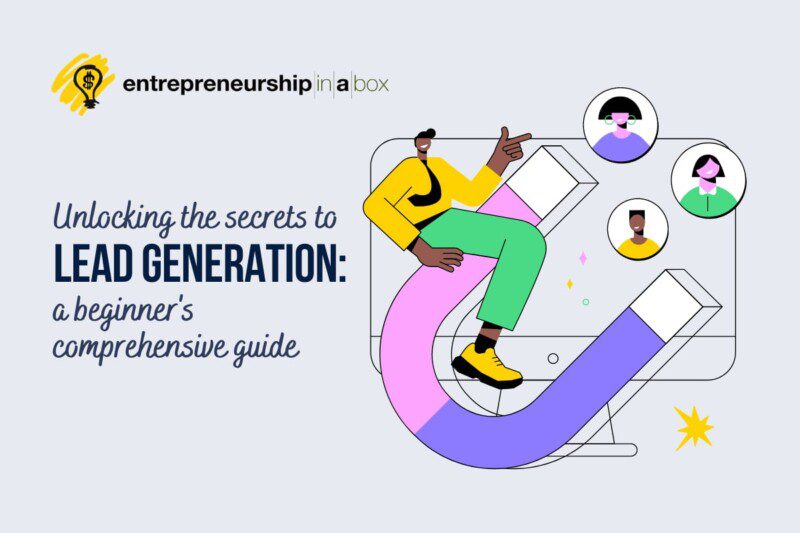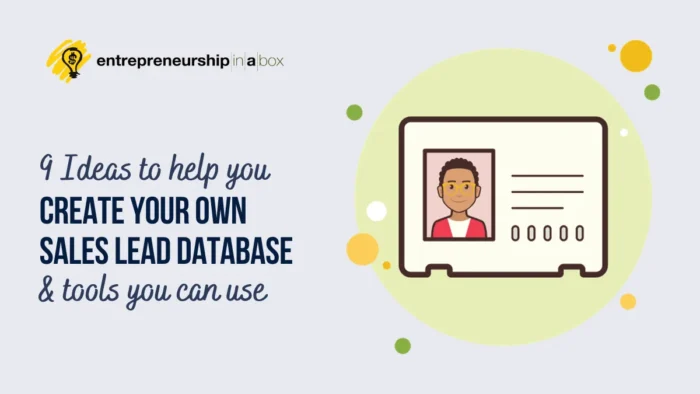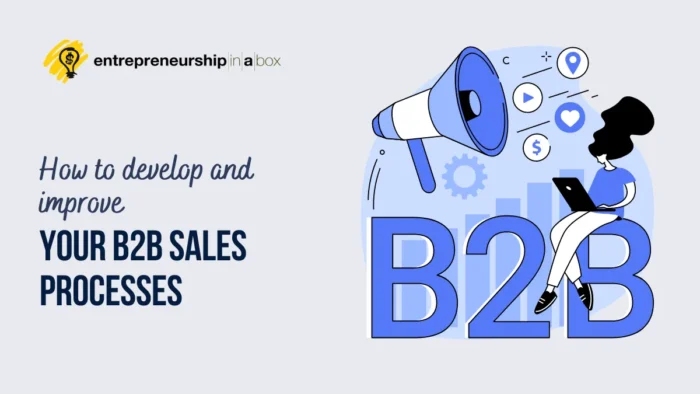When I first dipped my toes into the entrepreneurial waters in 2007, I quickly learned that lead generation is the lifeblood of any startup or small business. As a beginner, I found it crucial to attract and engage potential customers, paving the way for conversions and ultimately driving growth. However, navigating the complex world of lead generation can be daunting for those just starting.
I remember being a complete newbie to lead generation, unsure of where to begin or what strategies to use. Through trial and error (and a few amusing blunders), I gradually discovered the secrets to unlocking the potential of lead generation for my business. Now, I want to share my firsthand experiences and insights to help you embark on your own lead generation journey.
This guide is designed to provide a solid foundation for beginners. We will explore essential strategies and tools to generate leads and grow your startup.
So, let’s dive into this dummies guide to lead generation!
Why Is Lead Generation Important for Businesses?
Efficient lead generation is crucial for businesses because it helps attract new leads, nurtures them through the sales funnel, and ultimately turns them into paying customers.
The importance of lead generation lies in its ability to bring new leads into your sales pipeline. This gives your sales team a constant flow of prospective customers to engage with.
Quality leads are the lifeblood of your business, and having a steady stream of high-quality leads ensures your marketing and sales teams can work together effectively to convert them into paying customers.
From my experience, efficient lead generation campaigns are just the beginning of a thriving business. By continuously adapting and refining your lead generation efforts, you’ll not only see a boost in high-quality leads but also experience sustained growth in your business.
Trust me. It’s worth it!
Related: The Team Effectiveness and Different Roles in Teams That Win
What is a Lead Gen
Lead generation is the process of attracting potential customers, or leads, to your business and nurturing them until they’re ready to buy your product or service. In essence, generating leads means capturing the interest of your target market and guiding them through the sales pipeline.
The lead gen process begins with identifying your targeted market, ideally prospects with the right purchase intent. Then, create a compelling lead generation campaign that speaks to their needs and interests. Whether it’s through content marketing, search engine optimization, or online advertising, the goal of lead capture is to attract leads and capture their information using lead magnets and landing pages.
Once you’ve captured leads, it’s essential to nurture them.
Lead nurturing involves providing relevant information and support to your leads, keeping them engaged, and moving them through the sales pipeline. This process includes using lead management software to track and manage leads, as well as implementing lead scoring processes to prioritize leads.
The final step in the lead gen process is converting sales lead into paying customer. This involves your sales teams engaging with sales qualified leads, addressing their concerns, and ultimately closing the deal.
Related: How to Develop and Improve Your B2B Sales Processes
Types of leads
Throughout my experience in lead gen, I’ve learned that not all leads are created equal. It’s essential to understand the different types of leads. This will ensure you focus your efforts on those most likely to convert. There are three primary types of leads:
🔓 Unlock the power of #LeadGeneration with this comprehensive guide for beginners! Boost your business & conquer the market 🚀Click to Post1. Marketing Qualified Lead (MQL)
MQLs are leads that have shown interest in your product or service, typically by engaging with your marketing campaigns, such as downloading a lead magnet or signing up for a newsletter.
These leads are not yet ready to buy but are prime candidates for lead nurturing efforts.
For example, a SaaS company offering project management software uses a freemium model to attract prospects. They consider users who sign up for their free version as MQLs.
A digital marketing agency specializing in content marketing, for example, creates valuable resources like e-books, webinars, and blog posts to generate MQLs. They track user behavior and identify leads who frequently engage with their content and express interest in their services.
On the other side, an online education platform offers a variety of courses for professionals seeking to enhance their skills. They use a combination of free webinars and blog posts to generate MQLs.
2. Sales Qualified Lead (SQL)
SQLs are leads that have been nurtured and are now ready to engage with your sales team.
They’ve shown a higher level of consumer interest in your offerings and are more likely to become paying customers.
For example, when MQLs generated for the SaaS company engage with the platform and complete certain actions like inviting team members or using advanced features, they become SQLs.
In the case of digital marketing agencies, already generated MQLs are then nurtured with personalized email campaigns, gradually converting them to SQLs.
On the other side, online education platforms use targeted email campaigns and personalized course recommendations to nurture their MQLs to SQLs.
3. Product Qualified Lead (PQL)
PQLs are leads that have used your product. This is through a free trial or freemium model, and have experienced the value firsthand.
These leads are more likely to convert to paying customers as they’ve already seen the benefits of your product.
For example, once these SQLs for SaaS companies request a full demo or reach out to the sales team for pricing, they are converted to PQLs. By segmenting its leads this way, the company can effectively target users with relevant content and offers, ultimately increasing its conversion rates.
Digital marketing agencies offer free consultations for potential clients, which are considered PQLs. By having separate nurturing campaigns for SQLs and PQLs, the agency can tailor their messaging to address specific pain points and improve its chances of winning new clients.
When it comes to online education platforms, those SQLs who enroll in free trial courses are considered PQLs, as they have experienced the platform’s value firsthand.
Related: 60 B2B Lead Generation Tactics and Strategies
By understanding the different types of potential leads and focusing your lead generation approach on attracting and nurturing high-quality prospects, you’ll be well on your way to building a successful business. Trust me. It’s a game-changer!
New to lead gen? Don’t fret! 😊 This beginner’s guide has all the secrets to unlocking your #LeadGeneration potential 🌟 Get started today ➡️Click to Post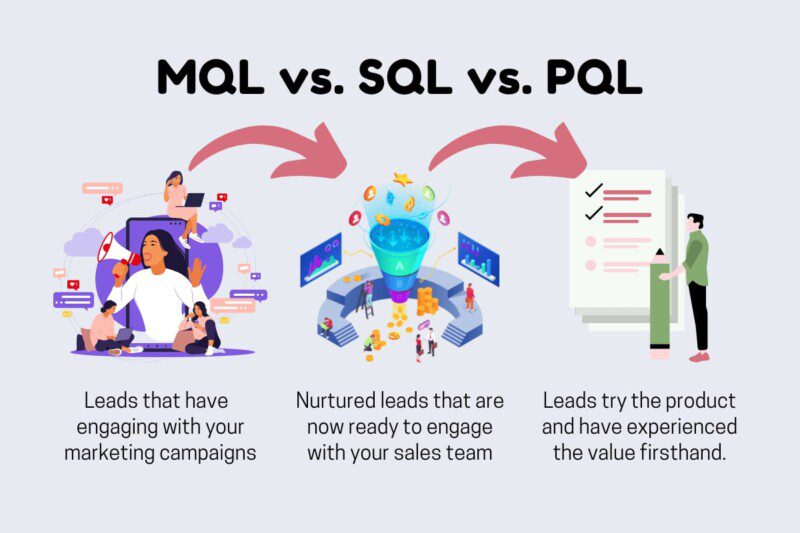
Building a Strong Foundation for Lead Generation
Identifying your target market
When I first started exploring lead generation, I quickly realized that it was crucial to know who I wanted to attract as my ideal customer.
Identifying your potential customer and target market is the first step in building a strong foundation for lead gen. By understanding who you’re trying to reach, you can create targeted marketing campaigns and content that speak to their needs and interests.
As I delved into my target market, I researched demographics, behaviors, and preferences. This was important for me to gain a better understanding of their pain points and desires. This information helped me craft tailored lead generation strategies and campaigns that attracted and engaged high-quality leads, ultimately boosting my sales pipeline.
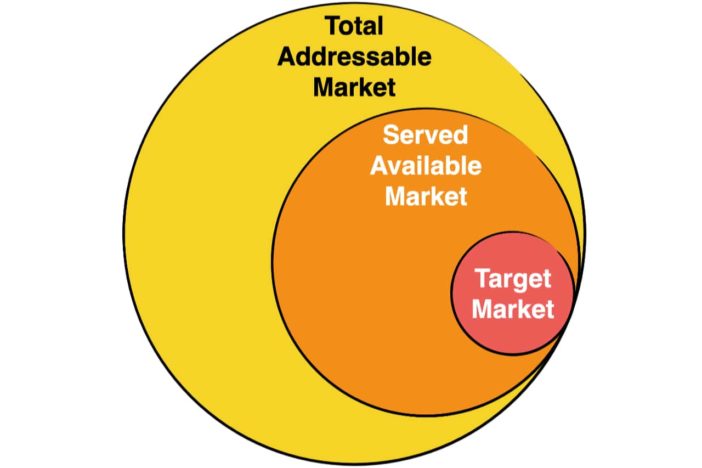
Creating a unique value proposition (UVP)
Another essential component of a successful lead gen foundation is having a unique value proposition. This is the superior combination of features, benefits, and pricing that sets your product or service apart from competitors. Here is an example of UVP with important elements that will need to be covered.
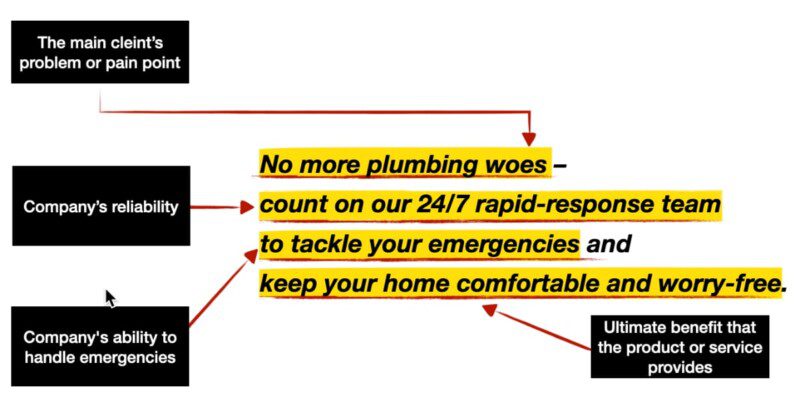
Remember that your unique value proposition is what entices potential customers to choose your business over others.
In my experience, crafting a compelling value proposition involved identifying my business’s strengths and highlighting them in my marketing campaigns. By communicating the unique benefits of my products and services, I was able to attract and engage leads, guiding them through the sales pipeline and converting them into paying customers.
Unlock the secrets to lead generation 🔑🔓 with this comprehensive beginner’s guide! Boost your business now! 💼Click to PostDeveloping a buyer persona
To truly understand and connect with my target market, I found that creating buyer personas was invaluable.
A buyer persona is a fictional representation of your ideal customer, incorporating their demographics, behaviors, preferences, and pain points. By developing buyer personas, you can better understand your target audience. Then you can tailor your marketing and lead generation process to their needs.
When I created buyer personas for my business, I used a combination of market research, customer data, and feedback from my sales and marketing teams. These personas helped me identify the most effective lead generation techniques and content for each segment of my audience, ultimately driving more targeted leads and improving lead quality.
By focusing on identifying your target audience, crafting a unique value proposition, and developing buyer personas, you’ll build a solid foundation for your lead generation approach. From my experience, these elements are essential for attracting and nurturing high-quality leads, ensuring a strong sales pipeline, and, ultimately, growing your business.
Trust me. It’s worth the investment!
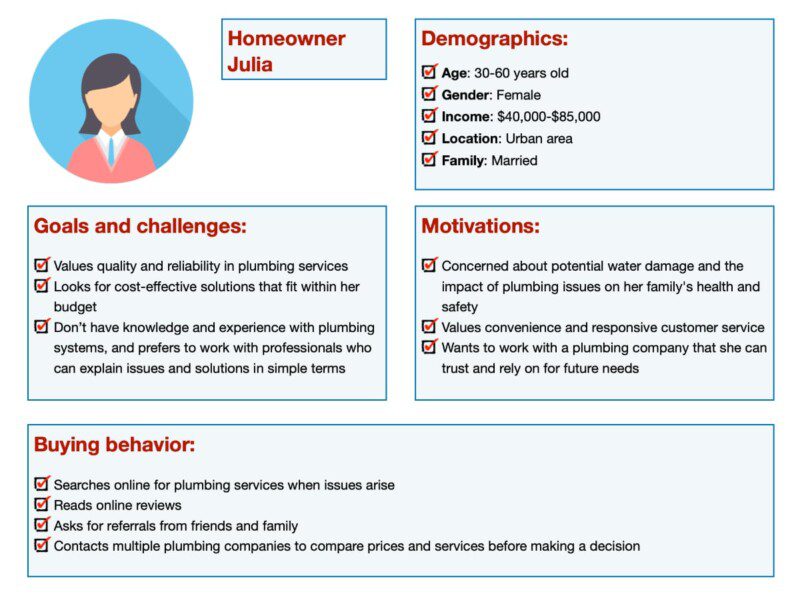
Lead Generation Strategies
Inbound Lead Generation Strategies
Content Marketing
When I first started my journey in lead gen, I quickly learned the power of content marketing. By creating valuable, engaging, and informative content that speaks to my target audience’s needs and interests, I was able to generate more leads and nurture them through the sales funnel.
Blog posts, e-books, webinars, and whitepapers are just a few examples of content formats that have helped me attract high-quality leads and establish my business as a trusted resource.
Search Engine Optimization (SEO)
Another vital inbound marketing strategy I’ve found useful is SEO. By optimizing my website and content for search engines, I’ve been able to improve my online visibility and attract more organic traffic, ultimately generating more quality leads.
By focusing on keyword research, on-page optimization, and link-building, I’ve managed to rank higher in search engine results pages (SERPs) and drive targeted leads to my site.
Social MediaMarketing
Social media marketing has been a game-changer for my lead generation approach.
By leveraging platforms like Facebook, Twitter, LinkedIn, and Instagram, I’ve been able to connect with my target audience. So, then I share valuable content to generate interest in my products and services.
By engaging with my audience and participating in relevant online communities, I’ve increased brand awareness and generated leads for my business.
Attract customers like a magnet 🧲 with this beginner’s guide to #LeadGeneration! Discover the secrets & skyrocket your success 📈Click to Post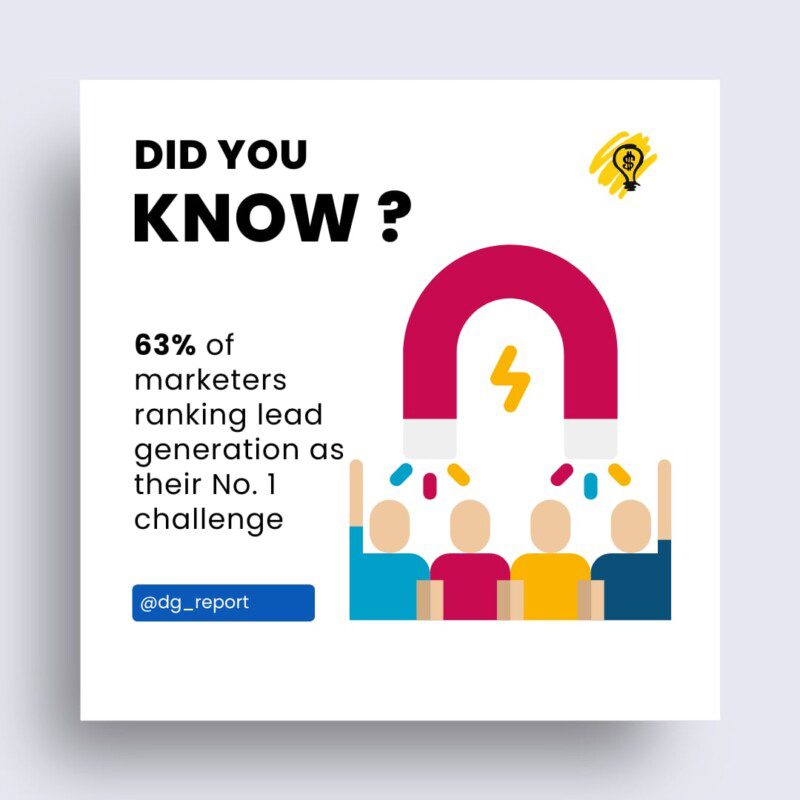
Outbound Lead Generation Strategies
Email Marketing
Email marketing remains one of the most effective outbound marketing strategies for generating leads.
By building targeted email lists and crafting personalized email campaigns, I’ve been able to nurture leads and guide them through the sales pipeline. With the right lead nurturing approach and compelling content, I’ve managed to convert potential customers into paying clients.
Cold Calling and Telemarketing
These lead gen campaigns are often seen as an outdated strategy. But cold calling and telemarketing can still be effective for lead generation when done right.
By carefully targeting my calls and crafting tailored pitches, I’ve managed to engage prospects and generate interest in my products and services. Combining this approach with other lead generation tactics, I’ve been able to diversify my lead generation approach and maximize my success.
Events and Tradeshows
Participating in events and tradeshows has been a fantastic way for me to generate leads and build valuable business relationships.
By showcasing my products and services, connecting with potential customers, and engaging in face-to-face conversations, I’ve managed to generate new business leads and foster lasting business connections that have proven invaluable to my company’s growth.
Want to ace lead gen? 🎯 This beginner’s guide spills the secrets to unlock the world of #LeadGeneration & grow your business 🌱Click to PostHybrid Lead Generation Strategies
Referral Marketing
Referral marketing is a powerful hybrid strategy that has helped me generate more leads and grow my business.
By incentivizing my existing customers to refer new clients, I’ve managed to tap into a network of warm leads who are more likely to convert into paying customers.
I remember that the most successful lead generation campaign was giving a freebie when the lead sent the message to 5 friends through a form on my website. In such a way, I have generated thousands of qualified leads for my company.
Influencer Marketing
Influencer marketing is another effective hybrid strategy for generating leads.
By partnering with influencers who have a strong connection with your target market, you will be able to leverage their reach and credibility to promote your products and services.
Using this lead generation strategy has helped me reach new audiences and generate more targeted leads for my business.
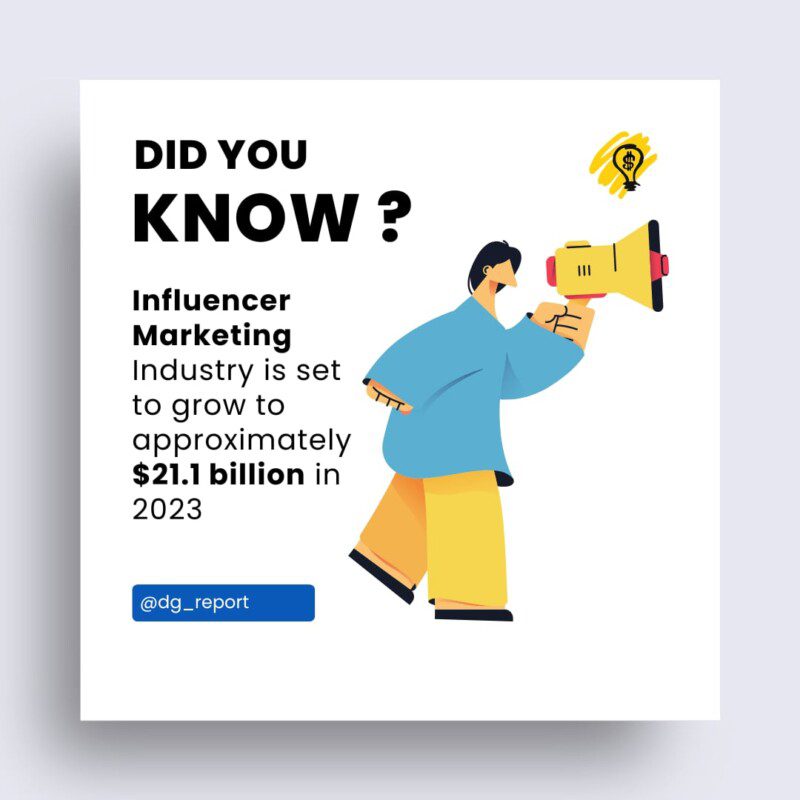
Strategic Partnerships
Finally, forming strategic partnerships with complementary businesses has been a fantastic way for me to generate leads and expand my reach.
By collaborating on joint marketing efforts, events, and product offerings, my partners and I have managed to generate leads and grow our businesses together.
Also, by exploring various offline and online lead generation channels and strategies, you can create a diverse and effective approach to attracting and nurturing leads.
From inbound marketing to outbound and hybrid strategies, experimenting with these tactics has been essential to my business’s growth and success in the competitive world of lead generation.
Converting Leads into Customers
But, the lead gen process can not finish with lead generation. The question is how we can convert those leads into customers. Three important processes can bring really astonishing results. Let’s look at them.
Lead Nurturing
In my experience, one of the most crucial aspects of lead generation is lead nurturing. It’s not enough to just generate leads; you need to incorporate lead management options.
For example, you will need to engage, educate, and build trust with prospects to guide them through the sales pipeline. To do this, I’ve used a combination of personalized email campaigns, relevant content, and timely follow-ups to address the needs and concerns of my leads.
By carefully nurturing my leads, I’ve managed to turn them into loyal customers. Customers who were excited about my products and services.
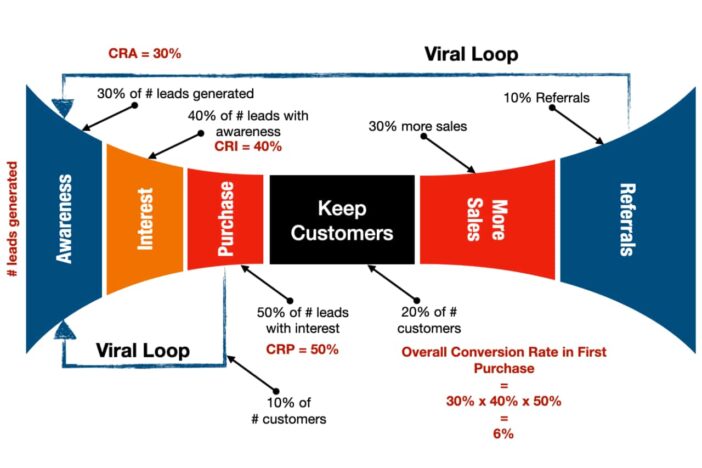
Sales Enablement
As a business owner, I’ve learned that supporting my sales team is vital to converting leads into customers.
Sales enablement involves equipping my sales team with the right tools, resources, and training. These tools help them to engage leads effectively and close deals.
By providing my sales and marketing team with the information they need about our products, services, and target market, I’ve empowered them to build strong relationships with prospects and successfully convert leads into paying clients.
Tracking and Measuring Success
Lastly, lead management through tracking and measuring the success of my lead generation approach has been critical in optimizing my strategies and improving my conversion rates.
By using various lead generation tools and analytics platforms, I’ve been able to monitor key performance indicators (KPIs) such as the number of leads generated, conversion rates, and RoI. By analyzing this data, I’ve been able to identify areas for improvement and adjust my strategies accordingly.
Lead Gen KPIs You Can Start With
To ensure that your lead generation strategy is effective, it’s crucial to track and measure your campaign’s performance using KPIs. Some important KPIs to monitor include:
The number of new leads.
This KPI helps you gauge the success of your lead generation efforts in attracting prospects to your sales funnel.
For example, if you are a plumbing company, you can track the number of inquiries received through phone calls, website forms, and social media messages from prospects interested in your plumbing services.
It’s time to generate leads like a pro! 💼 Unlock the secrets with this comprehensive guide for beginners & watch your business thrive 🌟Click to PostConversion rate.
This metric shows the percentage of leads that convert into paying customers. So, you can evaluate the effectiveness of your marketing and sales.
As an example, our plumbing company conversion rate will be the percentage of leads that turn into booked appointments or completed jobs.
Lead quality.
This KPI focuses on the value and likelihood of leads becoming customers. High-quality leads are more likely to convert and contribute to your sales pipeline. You can measure lead quality by analyzing various factors such as job size and profitability, lead source, conversion speed, etc.
For example, for a plumbing company, larger jobs or those with higher profit margins can be considered higher quality leads. They will also analyze the conversion rates of leads from different marketing channels (e.g., online advertising, referrals, social media) to determine which sources generate higher quality leads.
Regarding conversion rates, the plumbing company can analyze the conversion rates of leads from different marketing channels to determine which sources generate higher quality leads.
Cost per lead (CPL).
This metric helps you determine the efficiency of your lead generation campaigns. You need to calculate the average cost to acquire a new lead.
For example, a plumbing company will calculate the average cost of marketing efforts (such as online advertising, print ads, or social media promotions) to acquire a new lead. If they have spent $1000 for inbound lead generation and have generated 100 new leads, it means that CPL is $10 ($1000 spent divided by 100 leads generated)
Return on investment (ROI).
The ROI measures the revenue generated from your lead generation approach compared to the cost of those efforts. This helps you understand how much profit you’re making compared to the money you’re spending on your campaigns.
First, you need to calculate the costs of your campaign. This includes everything you spend on advertising, marketing materials, labor, software, or anything else connected to the campaign.
Next, calculate how much revenue the leads brought in.
And lastly, calculate the ROI by dividing the money earned from the leads by the cost of the campaign, then multiplying by 100 to get a percentage.
For example, let’s say your plumbing company spends $5,000 on a lead generation campaign, and you make $20,000 from the new customers it brings in. To find the ROI, you’d do the following math:
ROI = (Revenue – Cost) / Cost x 100
= ($20,000 – $5,000) / $5,000 x 100
ROI = 300%
A positive ROI means your lead generation marketing campaign is making money, while a negative ROI means you might need to rethink your marketing strategies or cut costs.
By keeping an eye on ROI, your company can make smart decisions about where to spend money and how to get the most out of your marketing efforts.
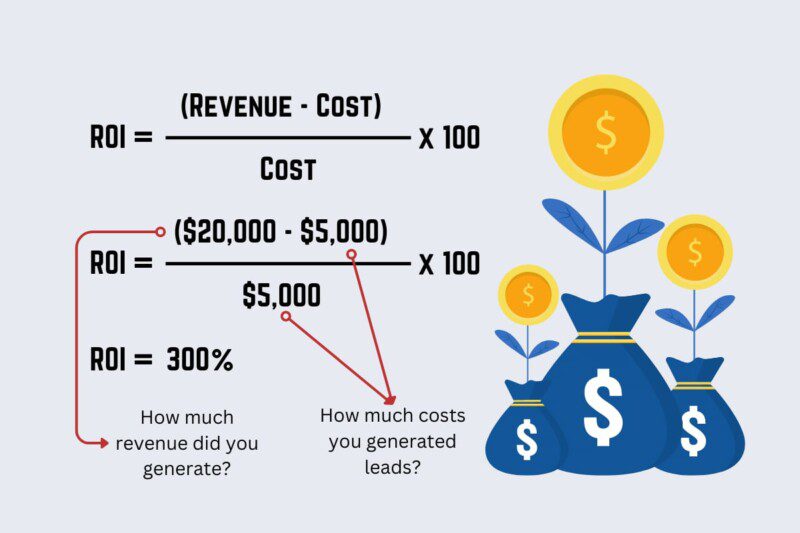
Lead Scoring
Lead scoring is an essential part of the inbound lead generation process. It involves assigning a numerical value to each lead based on their behavior, engagement, and demographic information.
The lead scoring process enables your marketing and sales teams to prioritize leads and focus on those with the highest potential to convert into customers.
For example, a plumbing company can score their leads
- Demographics. This is a score based on the potential customer’s location (e.g., proximity to your service area), property type (e.g., residential or commercial), and job size (e.g., a small repair or large installation).
- Behavior. This is a score based on the lead’s engagement with your plumbing company, such as visiting your website, reading blog posts, or following your social media accounts.
- Interaction. Give a higher score to leads that engage with your company through phone calls, email inquiries, or social media messages.
- Job urgency. Assign a higher score to leads with urgent plumbing issues that require immediate attention, such as burst pipes or severe leaks.
- Previous customer. Give a higher score to returning customers or referrals, as they are more likely to convert and become loyal clients.
As you can see, you will need to develop your scoring system based on different factors, as explained above.
How to Calculate Lead Score?
Let’s say you have a scoring system as in the image below:
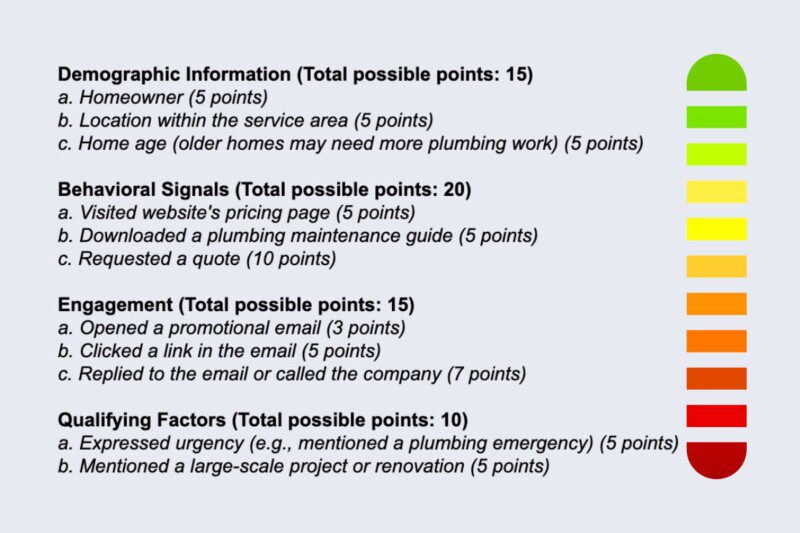
You can create a total score by adding up the points for each attribute.
For example, if a lead is a homeowner within your service area with an older home, visited your pricing page, downloaded a plumbing maintenance guide, opened a promotional email, and mentioned a plumbing emergency, their total score would be:
5 (homeowner) + 5 (location) + 5 (home age) + 5 (pricing page) + 5 (downloaded guide) + 3 (opened email) + 5 (expressed urgency) = 33 points
Based on the total points, you can classify the leads into different categories, such as:
- High priority (40-50 points). These leads are most likely to become customers and should be contacted immediately by your sales team.
- Medium priority (25-39 points). These leads show interest and potential but may require more nurturing before they’re ready to make a purchase.
- Low priority (0-24 points). These leads may not be ready to engage with your services yet or might not be a good fit for your business. Keep them in your system for future marketing efforts but prioritize other leads for now.
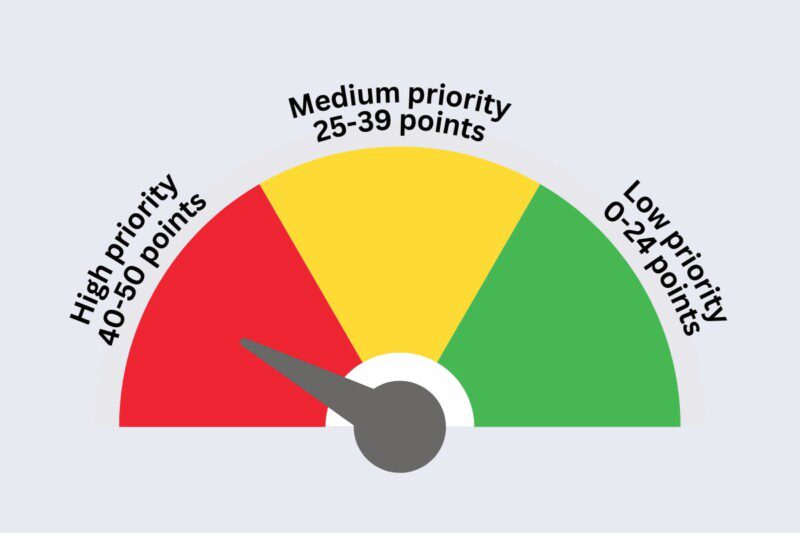
By focusing on key performance indicators and implementing a robust scoring system, you can optimize your marketing strategy. This will enable you to continuously improve lead quality through your lead generation efforts.
Remember, nurturing leads and building a strong relationship with prospective customers is essential for converting them into loyal, paying customers.
Lead Generation Tools
Customer Relationship Management (CRM) Systems
As an entrepreneur, I’ve found that leveraging lead generation tools is essential. One indispensable tool I’ve used is a customer relationship management (CRM) system.
CRM systems, such as HubSpot or Salesforce, help me manage and track my interactions with leads and customers, ensuring that I don’t miss any opportunities to engage and nurture them.
By centralizing all lead and customer data, these systems enable me to make data-driven decisions, segment my audience, and create targeted campaigns for lead generation that resonate with my prospects.
Marketing Automation Tools
Another powerful technology that has transformed my lead generation process is marketing automation. Tools like ConvertKit, and Agora or Social Pilot have streamlined my marketing efforts by automating repetitive tasks such as email marketing and social media posting.
By using these lead generation tools, I’ve been able to create personalized and timely messages for my leads, improving my engagement rates and overall lead quality.
For example, I’ve set up automated email campaigns that trigger based on specific actions taken by leads on my website or interactions with my content. These campaigns have helped me nurture leads more effectively and guide them through the sales pipeline.
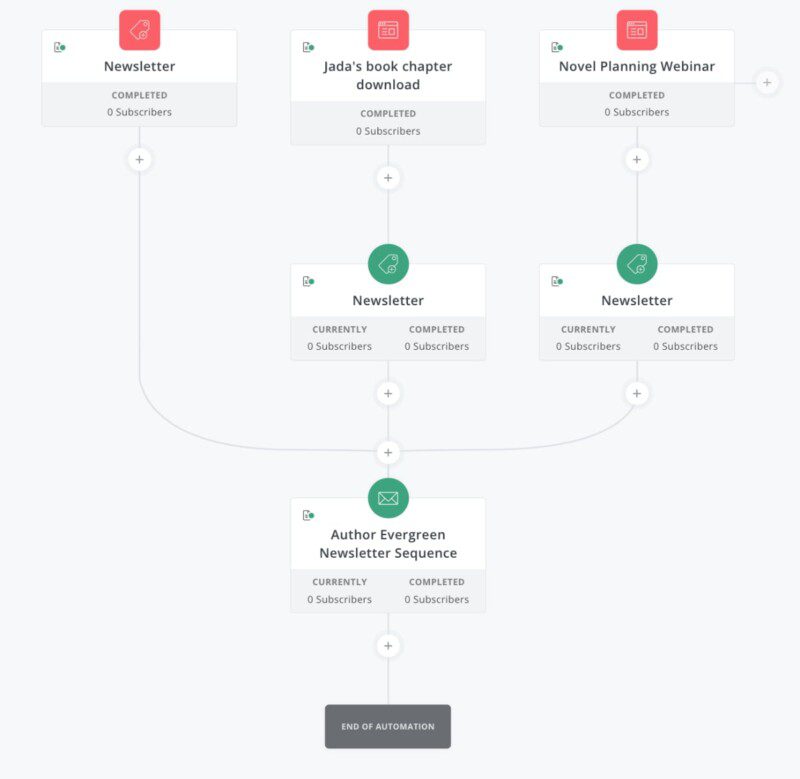
Analytics and Data-Driven Decision Making
Lastly, I’ve come to realize the importance of analytics and data-driven decision-making in my lead generation approach.
A tool like Google Analytics has allowed me to track the performance of my marketing campaigns and identify trends, enabling me to optimize my strategies and generate more quality leads.
By monitoring key metrics such as website traffic, conversion rates, and bounce rates, I’ve been able to gain valuable insights into what’s working and what’s not and make informed decisions about my lead generation tactics.
Tips and Best Practices for Successful Lead Generation
Quality over Quantity
One key lesson I’ve learned in my lead generation journey is the importance of prioritizing quality over quantity. While it’s tempting to focus on getting as many leads as possible, I’ve discovered that it’s more crucial to attract leads who are genuinely interested in my product or service. By honing in on my target market and creating targeted campaigns, I’ve been able to generate high-quality prospects that are more likely to convert into paying customers.
This approach has not only improved my sales pipeline but also allowed my sales team to focus on nurturing and closing deals with the right prospects.
Continuous Learning and Adapting
Lead generation is an ever-evolving landscape, and it’s essential to keep learning and adapting to stay ahead of the game. As an entrepreneur, I’ve made it a priority to stay informed about the latest trends, tools, and best practices in the industry. By attending webinars, reading blogs, and connecting with other professionals in the field, I’ve been able to gather valuable insights and apply them to my lead generation strategies.
This continuous learning has enabled me to stay agile and adjust my approach to ensure that I’m always generating prospects effectively and efficiently.
Test and Optimize Your Strategies
Lastly, I can’t stress enough the importance of testing and optimizing my lead generation strategies. In my experience, it’s crucial to experiment with different tactics, analyze the results, and make data-driven decisions to fine-tune my approach.
For instance, I’ve tested various landing page designs, email subject lines, and lead magnets to determine what resonates best with my target market. By analyzing the performance of these elements and making necessary adjustments, I’ve been able to boost my conversion rates and generate more leads.
Conclusion
If you’re just starting out in the world of lead generation, keep in mind that it’s a difficult and tedious process. Keeping your focus and determination strong is crucial.
Always remember that the backbone of every effective lead generation approach is a thorough understanding of your target customer, a clearly articulated USP, and the use of a systematic approach.
Don’t hesitate to try new things, make and learn from mistakes, and adjust your strategy as you go. Use these lead generation tips and tools to improve your lead generation efficiency and make smarter decisions.
Also, keep your eyes on generating high-quality prospects who will eventually become loyal buyers. An effective lead generation approach that generates results and expands your business will need time, effort, and the use of the appropriate technique.
Have success in your attempts at generating leads, and remember to always be open to improvement and adopting new strategies and methods.
Actionable Steps to Improve Your Lead Generation Strategy
Download this PDF guide and use it as a roadmap to improve your lead generation strategy. By following these actionable steps, you’ll be well on your way to generating high-quality leads and growing your business.

